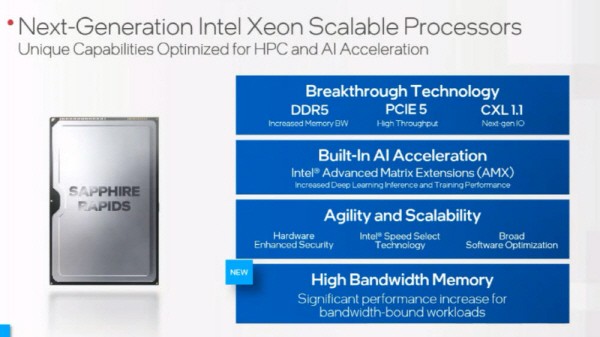International supercomputing conference keynote
CPU 'Sapphire Rapids' testing underway at customer sites
Applied enhanced super-pin/DDR5 memory for the first time
GPU 'Ponte Vecchio' to be announc

Intel will mass-produce next-generation central processing units (CPU) and graphics processing units (GPU) next year to preoccupy the high-performance computing (HPC) market. Applying the industry technology for the first time, the products have been differentiated from competitors such as AMD and Nvidia. Having declared 'IDM 2.0' to reenter the foundry business to regain its reputation as the technology of Intel, Intel has expressed its ambition to take the lead in technology in the HPC market such as supercomputers.
Trish Damkroger, Intel’s Vice President and General Manager of the High-Performance Computing Group, recently said at the keynote preview briefing of the International Super Computing Conference (ISC 2021), "We have provided Intel’s next-generation HPC CPU, Sapphire Rapids, to our customers and been testing them. We plan on starting production at the end of this year and ramp up mass production in the first half of next year. GPU Ponte Vecchio is also scheduled to be announced next year, so we will release the details as the release date approaches."
Sapphire Rapids is the sequel to the 3rd generation HPC Intel Xeon Scalable processor 'Ice Lake' that Intel unveiled in April. This is the first CPU to apply the 'Enhanced Super Fin' structure, which further improves the 'Super Fin' structure that uses the existing 10-nm process in maximum to increase power consumption and transistor operation speed. Sapphire Rapids also supports the industry's first DDR5 memory, which boasts 0.1V lower power consumption and 38% or more improved bandwidth compared to DDR4. DDR5 supported by Sapphire Rapids is expected to replace DDR4, the current trend in server memory, with high-bandwidth memory (HBM) support that significantly expands the memory bandwidth available to the CPU.
"Korea will take the lead in high-bandwidth memory production," said Seung-joo Na, Managing Director of Intel Korea. We view that high-bandwidth memory support is important related to Sapphire Rapids for Korean memory makers." This means that domestic memory makers’ demand for DDR5 will increase along with Intel's next-generation CPU. Intel's next-generation CPU roadmap is interpreted as the aspiration to take the lead in the rapidly growing HPC market, including cloud. Intel is poised to aggressively target the market with new CPUs, in order not to fall behind in the competition with the existing AMD and Nvidia.
The mass production of Sapphire Rapids is also a signal that Intel has successfully transitioned to a stable 10nm process. Sapphire Rapids is produced by Intel's own process, but it is projected that it will take time to actualize the 7-nano process that Intel is challenging itself to. Intel added, “The Ponte Vecchio, the next-generation GPU, will be produced in a 7-nano process, but it will be outsourced (through foundry).”
By Staff Reporter Kwon Dong-jun djkwon@etnews.com